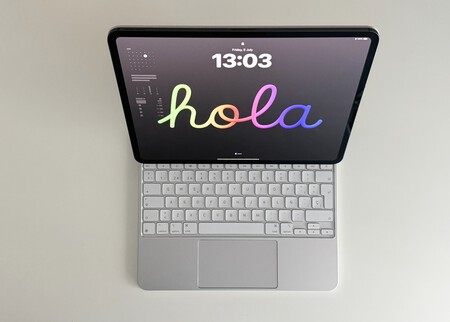The iPad has been an aspirational product for me for some time now. Not so much because I want to buy it, but because I want it to become an important product for me. Right now it isn’t: I only use it for leisure on the go or to watch games without always taking over the TV at home. I would love it to be something more.
Looking at the iPad Pro with the M4 chip, and not having much hope that iPadOS 18 would change things much (it hasn’t), I considered trying to use it as my primary computer, replacing my 2021 MacBook Pro.
A look into the future
Taking the iPad Pro out of its box has a negative effect wowWhether you like Apple a lot, a little or not at all, no one can deny what it feels like to see a device like this, 5.1 mm thick. Its design is impeccable.
- Extremely thin and light.
- Spectacular 13-inch OLED display.
- M4 chip, the same one used in next-generation Macs.
- A front camera at last on the long side, perfect for video calls.

Image: Xataka.
I docked the Magic Keyboard and saw what looks like the MacBook of the future: a massive touchscreen, a keyboard that can detach when you don’t need it, and the power of a Mac in an ultraportable form factor.
Where the iPad shines
There are tasks where the iPad doesn’t match or surpass my MacBook:
- Multimedia consumptionWatching series and movies, reading articles or watching sports is a fantastic experience. The OLED screen and the possibility of using it as a tablet make it unbeatable.
- Note taking, brainstormingWith Apple Pencil Pro, apps like Freeform either Goodnotes become very powerful tools. Drawing, sketching or jotting down ideas is very satisfying.
- Photo editing. With Pixelmator Photo (or equivalents such as Affinity Photo) I was able to take full advantage of the touch screen and the Pencil, editing becomes more precise and the OLED panel is very pleasant.
- Video calls. The new camera position and Center Stage feature, which keeps you centered even when you move, improve video calls.
- Extreme portability. Taking the iPad Pro to a coffee shop, any mobility support or even using it on the couch is more comfortable and versatile than a traditional laptop.


One detail I particularly appreciate about the Magic Keyboard is its additional USB-C connector, only suitable for charging. It frees up the iPad’s only port and allows the charging cable to sit at table height, not elevated. Image: Xataka.
Where the iPad falls short
As the days went by I began to encounter quite a few limitations:
- File managementThe native Files app is a good way to get by, but it’s a far cry from macOS’s. Using external drives or organizing large amounts of files is very limited.
- Multitask. Something that improved with the Visual Organizerbut it’s still less fluid than on macOS. Working with multiple windows and applications simultaneously isn’t as intuitive or fluid.
- Software Compatibility. This depends on what each person uses, but some professional applications continue to be non-existent in iPadOS, or they exist, but in a very limited way to their desktop version.
- Customization and advanced capabilities. A big help on my Mac are the little utilities hidden in corners of the system: the context menu, the menu bar, background processes… This is almost non-existent in iPadOS due to system restrictions, very similar to those of iOS.

An example of the latter: on a Mac I use the app Paste to give my clipboard a large memory and not lose anything I’ve copied to it, or to quickly locate something I copied days ago. This type of app is a pipedream on the iPad. On Windows it’s a native feature.
The elephant in the room: iPadOS
Here’s the bottom line. The iPad Pro looks amazing and has top-notch hardware. It’s thin, powerful, versatile. It has the same M4 chip that will power many Macs this year and next.
Plus, its detachable keyboard and large touchscreen make this device even more versatile. It’s a joy… until you start needing something more.
Then comes iPadOS and you realise that, despite its improvements, it is still an operating system designed for tablets and inherited from mobile devices, not something designed from scratch for professional productivity computers.
The Surface Pro leads the way with the same versatility but much more complete in terms of productivity. Without a desktop operating system, or an iPadOS freed from its atavistic limitations, trying to focus on the iPad Pro as a productive device is a futile attempt. With shortcomings, with frustrations, with work oriented to making the process possible, not the result.
I’ve found myself wanting to turn the iPad Pro into my computer far more than I have the actual ability to make the iPad into that role.
So close and yet so far
My verdict is bittersweet. More bitter than sweet. The iPad Pro is an incredible device. I’m sure that for many users it can completely replace a traditional laptop.
If your work focuses on creative tasks, especially those that make use of the Pencil, content consumption, or basic office tasks, the iPad Pro will probably be sufficient.
However, for professionals who need the full flexibility of a desktop operating system, the iPad Pro still falls short. It’s not a hardware issue, it’s iPadOS that imposes limitations that result in tasks that are impossible to do or frustrating to complete.

There are four iPad families (mini, base, Air, Pro) and iPadOS runs on all of them. It makes no sense for an 8-inch model that costs 400 euros to run exactly the same operating system as a 13-inch model that costs 1,500 euros. The same logic applies to Macs.
My hope is that at some point Apple creates its own narrative about the iPad as the computer of the future and elevates it with an iPadOS that matches its hardware, or just lets it run macOS on the Pros. Does the iPad have an attached keyboard and trackpad? macOS. Is it loose? iPadOS.
Until either of those options come to fruition, the iPad Pro will remain a great concept for the future with the problem is that we live in the present, not the future. And the horizon it raises has been postponed for a long time.
Featured image | Xataka
At Xataka | The best 24 free iPad apps to get the most out of your tablet















![[Img #74130]](https://thelatestnews.world/wp-content/uploads/2024/10/Richard-Dawkins-The-scientist-who-changed-our-understanding-of-evolution-300x200.jpg)
Add Comment